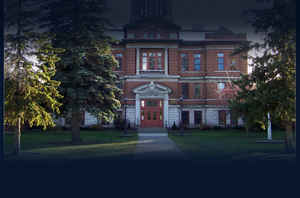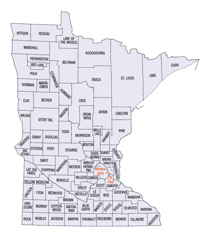Minnesota Counties
There are eighty-seven Counties in Minnesota. On October 27, 1849 nine large Minnesota Counties were created. Among them were Benton, Dahkotah, Itasca, Ramsey, Mahkahta, Pembina, Wabashaw, Washington, and Wahnata. Of those Benton, Dakota, Itasca, Ramsey, Wabasha, and Washington still exist as their original name. With the creation of Kittson County on March 9, 1878, Pembina County no longer existed. When Minnesota was organized as a state, 57 of the present 87 Counties were established. The last county to be created was Lake of the Woods County in 1923Koochiching County, Minnesota
Koochiching County Education, Geography, and History
Koochiching County is a county located in the state of Minnesota. Based on the 2010 census, the population was 13,311. Its county seat is International Falls. A portion of the Bois Forte Indian Reservation is in the county. A small part of Voyageurs National Park extends into its boundary, with Lake of the Woods County to its northwest.
Etymology - Origin of Koochiching County Name
The Ojibway version of the Cree name for Rainy Lake and Rainy River.
Demographics:
County QuickFacts: CensusBureau Quick Facts
Koochiching County History
Koochiching County was created on December 19, 1906 from Itasca County. The county was named for the Ojibway version of the Cree name for Rainy Lake and Rainy River.
History makers of Koochiching County were of many occupations. They were explorers, traders, homesteaders, and lumberjacks. They also were teachers, preachers, merchants, engineers, and builders of industry. Settlers came at the beginning of the 1900s and suffered through isolation, illness, harsh weather, and poverty. They built schools, churches, and good roads. Koochiching County is the second largest county in area next to Saint Louis County. It is also one of the youngest counties in the state having been created in 1906 after it was separated from Itasca County. The name "Koochiching" comes from either the Ojibwe word Gojijiing or Cree Kocicahk (recorded in some documents as "Ouchichiq"), both meaning "at the place of inlets," referring to the neighboring Rainy Lake and River. Reverend J.A. Gilfillan recorded their meaning, "according to some, Neighbor lake, according to others a lake somewhere," possibly referring to the neighbouring Rainy Lake and to Lake Couchiching located in southern Ontario. Early European (French) inhabitants gave the names Lac la Pluie (Rainy Lake) and Riviere ? la Pluie (Rainy River) to the nearby bodies of water because of the mist-like rain present at the falls of Rainy River and then to the settlement that became known as International Falls. About 10,000 years ago almost 90% of Koochiching County was covered by Lake Agassiz. When it receded it left low areas of decayed vegetation (muskeg); as a result, three-quarters of northern Koochiching are underlain with 2 to 50 feet of peat
Geography: Land and Water
As reported by the Census Bureau, the county has a total area of 3,154 square miles (8,170 km2), of which 3,104 square miles (8,040 km2)
is land and 50 square miles (130 km2) (1.6%) is water. It is the second-largest county in Minnesota by land area and third-largest by total
area.
Major rivers in the county are Big Fork River, Little Fork River, Rat Root River, Black River, and Rapid River. The highest altitude in the
county is in the Northome area which is 1426 feet above sea level which is about 325 feet higher than Rainy Lake. The land surface is mostly
flat with swampy areas where Lake Agassiz basin was deepest. There are also deposits of peat from 1-1/2 to 50 feet in the low areas which is a
result from vegetation. The general surface of Koochiching County is flat with spots of land broken in places by ledges of precambrian rock.
Bed rock in the area includes ely greenstone and greenstone schists that are said to be among the oldest on the planet. In the northeastern
tip of the county is a section of Voyageurs National Park and Black Bay. Franz Jevne State Park is located on Rainy River between
International Falls and Baudette.
Neighboring Counties
Bordering counties are as follows:
- Rainy River District, Ontario (north)
- Saint Louis County (east)
- Itasca County (south)
- Beltrami County (southwest)
- Lake of the Woods County (northwest)
Education







